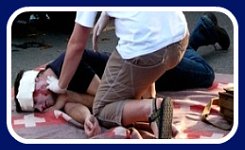Basic First Aid Instructions
Can Save Lives

Basic First Aid Instructions are so vital as it is the person on the spot, not a doctor or ambulance officer, that will clear a blocked airway and do CPR, stop bleeding or assist someone injured to become safe.
Then there is the more common issues of nosebleeds, sunburn, cuts, bites, stings and the like that need first aid treatment.
Knowing basic first aid instructions allows you to quickly determine a person's physical condition and the correct course of treatment.
In a number of scenarios, basic first aid instructions can be the complete treatment and then there are more life threatening conditions that may only need basic actions to save a person's life.
The below links will help by teaching you about the details of emergency conditions and many other injury treatments.
Or if you want to go to a specific first aid issue on our web site simply use the search option below:
So let's have a look:
First Aid for Bleeding - The loss of excess blood can be life threatening. Therefore stopping the loss of blood from a bleeding person is one of the most important things you can do to save their life. Click on any of the below links to go straight to the particular issue you are needing help for.
- First Aid for Nosebleeds
- First Aid for Severe Bleeding - External
- First Aid for Internal Bleeding
- First Aid for Uncontrolled Bleeding
First Aid for Bee Stings - Bee stings can be fatal depending on the body's response to the bee's venom. Find out what to do for bee sting first aid.
First Aid for Cuts and Scrapes - Knowing first aid for cuts when someone has been hurt can make a big difference to the outcome. Often cuts and scrapes can be treated at home, but more severe cuts require prompt first aid and may need medical attention.
First Aid for Shock – Untreated, shock can be fatal. Giving First Aid for Shock and saving someone's life is the priority over dealing with a non life-threatening injury. Shock, the loss of blood flow from the body, frequently occurs following physical and occasionally psychological trauma. Anyone who has suffered a severe injury or life-threatening situation is at risk for shock.
First Aid for Burns - There are two approaches to First Aid for Burns and the treatment depends on the depth and extent of the tissue injury. Therefore, First Aid for Major Burns is different to First Aid for Minor Burns. Burns, small or large, need First Aid Immediately.
- Minor burns are first degree burns and small second degree burns (smaller than 3 inches or 7.5 cm diameter). Learn what to do with First Aid for Minor Burns.
- Major/Severe Burns are larger and deeper than minor burns. They are second degree burns larger than the person's abdomen or the area of their hand spread out or Full thickness burns.
First Aid for Sunburn - Once you are sunburnt the damage is done so click on the link to see how to ease the discomfort. Go to First aid for sunburn to learn first aid hints to treat sunburn.
First Aid for Frostbite - Frostbite occurs when areas of the body are exposed to extremely cold temperatures resulting in the skin and/or underlying tissues literally freezing. Go to Frostbite Information for more in depth information on this type of injury.
First Aid for Fractures - A fracture is a break or crack in a bone. It is not always possible to tell if a bone has been fractured. If you are not sure it is best to assume it is and treat it accordingly. Find out about types and signs of a fracture.
Jelly Fish Stings and other Marine Life First Aid - Apart from Jelly fish stings there are a whole host of other sea creatures you can get stung by. Stings from marine life hurt but usually aren't deadly, there are a few exceptions. Here is a variety of marine life that can cause bites or stings...
Heatstroke or Heat Exhaustion - When temperatures rise so does the risk of heat exhaustion and heatstroke. Being outdoors in hot humid weather can quickly lead to dehydration.
Basic first aid is the front line of medical treatment. Whether there is an injury or sickness, knowing or having access to basic first aid instructions will empower you to help, which can mean the difference between life and death.
So now you have looked through many of the Basic First Aid instructions on this site you would have discovered that you need a First Aid Kit, maybe for your home, car, motorcycle or next backpacking or hiking trip. Then checkout our First Aid Kit Checklists.